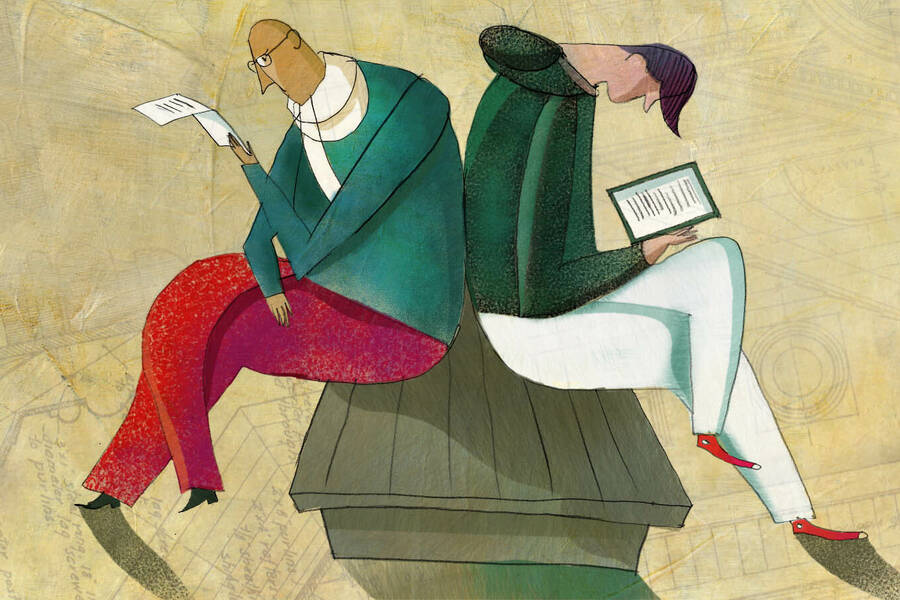Healthcare Sep 1, 2022
How Humanizing Disease Could Be a New Public Health Tool
Anthropomorphizing a disease changes how we feel about it—and the steps we take to avoid it.

Yevgenia Nayberg
What steps are you willing to take to avoid COVID-19? What if you were asked to avoid “Mr. COVID,” the stealthy undercover agent who tries to evade your immune system?
According to a new study from the Kellogg School, you’ll probably take greater precautions against a sneaky agent than a plain old virus. The research shows that people are more likely to comply with health recommendations when diseases are anthropomorphized and given human-like traits, such as names, personalities, or jobs.
“If you think of a disease in human terms, you will be more likely to try to avoid it,” says Maferima Touré-Tillery, an associate professor of marketing. She coauthored the paper alongside Lili Wang of Zhejiang University and Ann L. McGill of the University of Chicago Booth School of Business.
Previous research has shown that anthropomorphizing our cars and dogs makes us feel closer to them; the same, it turns out, is true of diseases. Closeness to the disease, the researchers found, triggers feelings of vulnerability. “Thinking of a disease in human terms—terms that are closer to me—makes me feel more vulnerable,” Touré-Tillery explains. “And that’s what motivates people to say, ‘Maybe I should wear a mask’ or ‘Maybe I should get this vaccine.’”
Taking Steps to Avoid Mr. (or Ms.) Disease
The researchers conducted several studies to establish the link between anthropomorphism and health compliance. In one, they recruited 166 American participants to complete an online study. Participants read about a scenario in which they might be exposed to yellow fever, a viral infection spread through mosquito bites. For half the participants, the ailment was anthropomorphized as “Mr. Yellow Fever”; for the other half, it was described simply as “yellow fever.”
Then, participants rated from one to seven how likely they would be to take various precautions against yellow fever, such as getting a vaccine before traveling. They also answered basic demographic questions and disclosed whether they had any personal experience with yellow fever. (If they did, the researchers excluded them from the analysis.)
Participants were more likely to take precautions against “Mr. Yellow Fever” than just “yellow fever,” the researchers found.
“Thinking of a disease in human terms—terms that are closer to me—makes me feel more vulnerable.”
— Maferima Touré-Tillery
The researchers found the same pattern in several other experiments. Participants were more willing to comply with health recommendations when facing anthropomorphized as compared with non-anthropomorphized COVID-19. They were also more likely to take precautions against a humanized noninfectious disease, breast cancer. These experiments involved both American and Chinese participants, suggesting that the tendency to change behavior in response to anthropomorphized diseases is cross-cultural. However, Touré-Tillery recommends that health communicators find a method of anthropomorphizing a disease that produces positive results, because it’s humanized but at the same time doesn’t downplay the seriousness of the health condition.
From Closeness to Vulnerability
The first phase of the study showed that people take greater precautions against anthropomorphized diseases but didn’t reveal why. So, in their next set of experiments, the researchers decided to investigate the mechanism behind the pattern they were seeing.
They recruited 308 women students at a Chinese university and randomly assigned them to one of two groups. In the first group, participants read about non-anthropomorphized breast cancer; in the second, breast cancer described itself in the first person (“I am breast cancer”). Next, all participants read about the importance of breast self-exams.
Then, participants indicated how likely they would be to perform a breast self-exam in the next week. They also indicated how close they felt to breast cancer; how concrete versus abstract the disease felt to them; and how vivid, alert, and in control of it they felt—all possible explanations for why anthropomorphism might trigger increased compliance with health recommendations.
In line with the previous experiments, participants in the anthropomorphized group reported higher intentions to perform a breast self-exam than those in the control group. (Participants who had a previous diagnosis of breast cancer were excluded from the analysis.) They also felt more psychological closeness and vulnerability to the disease. There was no difference between anthropomorphized- and control-group participants in measures of concreteness, vividness, alertness, and control, indicating that these factors did not explain their greater intentions to perform a breast self-exam.
The researchers conducted further statistical analysis that showed what Touré-Tillery calls “a causal chain reaction”: anthropomorphism leads to greater feelings of psychological closeness, which in turn creates a greater feeling of vulnerability, resulting in more willingness to comply with health recommendations.
In a second experiment, using a nearly identical setup, the researchers ruled out several other possible explanations for the effect. They asked participants about self-efficacy (“To what extent do you feel capable of taking the steps necessary to avoid breast cancer?”), disease severity (“How serious of a health problem is breast cancer?”), and response efficacy (“To what extent do you believe breast self-exam is an effective way to avoid breast cancer?”)—all factors that have been shown to influence health behavior.
“We wanted to see whether these processes could explain the effect that we observed, but we found that that was not the case,” Touré-Tillery says—further bolstering their explanation of an anthropomorphism–closeness–vulnerability chain reaction.
When Disease Anthropomorphism Helps Most
So, how can anthropomorphism be deployed most effectively to promote public health? Touré-Tillery says the benefits are strongest among people who aren’t already particularly concerned about or alert to a particular disease.
For instance, men are much less likely to wear sunscreen regularly or to understand its benefits than women, so an anthropomorphized skin cancer character is more likely to meaningfully change their behavior.
“Be specific in your targeting,” Touré-Tillery advises. “When we’re messaging, we want to reach people who are not already engaging in the health behaviors. It may be because they just don’t know or because they don’t feel particularly vulnerable to the disease. And anthropomorphism can help them understand their vulnerability in a very subtle way.”
She hopes future research will explore how the specific type of anthropomorphism may influence what precautions people are willing to take. For instance, the experiments in this study used “Mr.”—would participants respond to “Ms. Yellow Fever” in the same way? Would it vary between men and women participants? Could anthropomorphizing health-promoting behaviors themselves have a beneficial effect?
“It would be important to identify other caveats and relevant contextual factors,” she says.
Susie Allen is a freelance writer in Chicago.
Wang, Lili, Maferima Touré-Tillery, and Ann L. McGill. 2022. “The Effect of Disease Anthropomorphism on Compliance with Health Recommendations.” Journal of the Academy of Marketing Science.



